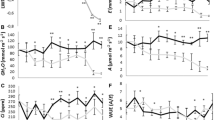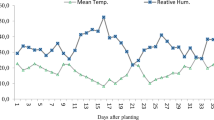Abstract
For 20 weeks, the physiological responses of Euonymus japonica plants to different irrigation sources were studied. Four irrigation treatments were applied at 100 % water holding capacity: control (electrical conductivity (EC) <0.9 dS m−1); irrigation water normally used in the area (irrigator’s water) IW (EC: 1.7 dS m−1); NaCl solution, NaCl (EC: 4 dS m−1); and wastewater, WW (EC: 4 dS m−1). This was followed by a recovery period of 13 weeks, when all the plants were rewatered with the same amount and quality of irrigation water as the control plants. Despite the differences in the chemical properties of the water used, the plants irrigated with NaCl and WW showed similar alterations in growth and size compared with the control even at the end of the recovery period. Leaf number was affected even when the EC of the irrigation water was of 1.7 dS m−1 (IW), indicating the salt sensitivity of this parameter. Stomatal conductance (gs) and photosynthesis (Pn), as well as stem water potential (Ψstem), were most affected in plants irrigated with the most saline waters (NaCl and WW). At the end of the experiment the above parameters recovered, while IW plants showed similar values to the control. The higher Na+ and Cl+ uptake by NaCl and WW plants led them to show osmotic adjustment throughout the experiment. The highest amount of boron found in WW plants did not affect root growth. Wastewater can be used as a water management strategy for ornamental plant production, as long as the water quality is not too saline, since the negative effect of salt on the aesthetic value of plants need to be taken into consideration.



Similar content being viewed by others
Abbreviations
- EC:
-
Electrical conductivity
- DW:
-
Dry weight
- gs :
-
Stomatal conductance
- J:
-
Absorption rate of ions by roots
- NTU:
-
Nephelometrical Turbidity Units
- P:
-
Significance level
- PAC:
-
Percentage of plants in acceptable conditions
- PDB:
-
Percentage of plants with dry branches
- PIC:
-
Percentage of plants in ideal conditions
- DP:
-
Percentage of dry plants
- Pn :
-
Net photosynthesis
- RH:
-
Relative humidity
- TDS:
-
Total dissolved solids
- VPD:
-
Vapour pressure deficit
- Ψstem :
-
Stem water potential
- Ψ100s :
-
Osmotic potential at full turgor
References
Aiello R, Cirelli GL, Consoni S (2007) Effects of reclaimed wastewater irrigation on soil and tomato fruits: a case study in Sicily (Italy). Agr Water Manage 93:65–72
Álvarez S, Gómez-Bellot MJ, Castillo M, Bañón S, Sánchez-Blanco MJ (2012) Osmotic and saline effect on growth, water relations, and ion uptake and translocation in Phlomis purpurea plants. Environ Exp Bot 78:138–145
Aucejo A, Ferrer J, Gabaldón P, Marzal P, Seco A (1997) Toxicity in citrus plantations in Villarreal, Spain. Water Air Soil Pollut 94:349–360
Bañón S, Miralles J, Ochoa J, Franco JA, Sánchez-Blanco MJ (2011) Effects of diluted and undiluted treated wastewater on the growth, physiological aspects and visual quality of potted lantana and polygala plants. Sci Hortic 129:869–876
Bañón S, Miralles J, Ochoa J, Sánchez-Blanco MJ (2012) The effect of salinity and high boron on growth, photosynthetic activity and mineral contents of two ornamental shrubs. Hort Sci 39:188–194
Bansal RL, Nayyar VK, Takkar PN (1992) Accumulation and bioavailability of Zn, Cu, Mn and Fe in soils polluted with industrial wastewater. J Indian Soc Soil Sci 40:796–799
Barar MS, Mahli SS, Singh AP, Aroroa CL, Gill KS (2000) Sewer water irrigation effects on some potentially toxic trace elements in soil and potato plants in northwestern India. Can J Soil Sci 80:465–471
Bennett WF (1993) Nutrient deficiencies and toxicities in crop plants. APS Press, Minnesota
Cervilla LM, Blasco B, Ríos JJ, Rosales MA, Rubio-Wilhelmi MM, Sánchez-Rodríguez E, Romero R, Ruiz JM (2009) Response of nitrogen metabolism to boron toxicity in tomato plants. Plant Biol 5:671–677
Chapman HD (1968) The mineral nutrition of citrus. In: Reuther LD, Batchebor, Webber HJ (eds) The Citrus Industry. pp 127–274
Flexas J, Bota J, Loreto F, Cornic G, Sharkey TD (2004) Diffusive and metabolic limitations to photosynthesis under drought and salinity in C3 plants. Plant Biol 6:269–279
Fornes F, Belda RM, Carrión C, Noguera V, García-Agustín P, Abad M (2007) Pre-conditioning ornamental plants to drought by mean of saline water irrigation as related to salinity tolerance. Sci Hortic 113:52–59
Gori R, Ferrini F, Nicese FP, Lubello C (2000) Effect of reclaimed wastewater on the growth and nutrient content of three landscape shrubs. J Environ Hort 18:108–114
Greenway M, Munns R (1980) Mechanisms of salt tolerance in nonhalophytes. Ann Rev Plant Physiol 31:149–190
Gucci R, Xiloyannis C, Flore JA (1991) Gas exchange parameters, water relations and carbohydrate partitioning in leaves of field-grown Prunus domestica L. following fruit removal. Physiol Plant 83:497–505
Iannelli MA, Pietrini F, Fiore L, Petrilli L, Massacci A (2002) Antioxidant response to cadmium in Phragmites australis plants. Plant Physiol Biochem 40:977–982
Jordan FL, Yoklic M, Morino K, Brown P, Seaman R, Glenn EP (2009) Consumptive water use and stomatal conductance of Atriplex lentiformis irrigated with industrial brine in a desert irrigation district. Agr Forest Meteorol 149:899–912
Kalavrouziotis IK, Kanatas PI, Papadopoulos AH, Bladenopoulou S, Koukoulakis PH, Leotsinides MN (2005) Effects of municipal reclaimed wastewater on the macro and microelement status of the soil and plants. Fresenius Environ Bull 14:1050–1057
Maria D, Tadeusz B (2005) Growth parameters and photosynthetic pigments in leaf segments of Zea mays exposed to cadmium, as related to protection mechanisms. Plant Physiol 162:1013–1021
Munns R, Tester M (2008) Mechanisms of salinity tolerance. Ann Rev Plant Biol 59:651–681
Navarro A, Bañón S, Olmos E, Sánchez-Blanco MJ (2007) Effects of sodium chloride on water potential components, hydraulic conductivity, gas exchange and leaf ultrastructure of Arbutus unedo plants. Plant Sci 172:473–480
Navarro A, Bañón S, Conejero W, Sánchez-Blanco MJ (2008) Ornamental characters, ion accumulation and water status in Arbutus unedo seedlings irrigated with saline water and subsequent relief and transplanting. Environ Exp Bot 62:364–370
Neumann PM (1997) Salinity resistance and plant growth revisited. Plant Cell Environ 20:1193–1119
Niu G, Rodriguez D (2006) Relative salt tolerance selected herbaceous perennials and groundcovers. Sci Hortic 110:352–358
Ouzounidou G, Giamporova M, Moustakas M, Karataglis S (1995) Response of maize (Zea mays L.) plants to copper stress. I. Growth, mineral content and ultrastructure of roots. Environ Exp Bot 35:167–176
Palaniswami C, Sree Ramulu US (1994) Effects of continuous irrigation with paper factory effluent on soil properties. J Indian Soc Soil Sci 42:139–140
Parson LR, Wheaton TA, Castle WS (2001) High application rates of reclaimed water benefit citrus tree growth and fruit production. HortScience 36:1273–1277
Passioura JB, Munns R (2000) Rapid environmental changes that affect leaf water status induce transient surges or pauses in leaf expansion rate. Aust J Plant Physiol 27:941–948
Pedrero F (2010) Manejo sostenible del riego con aguas regeneradas. PhD thesis. Dept Irrigation. CEBAS-CSIC. Murcia, Spain
Pitman MG (1975) Ion transport in whole plants. In: Baker DA, Hall JL (eds) Ion transport in plant cells and tissues. North-Holland Publishing Co, Amsterdam, pp 267–308
Rashid A (1986) Mechanism of salt tolerance in wheat (Triticum aestivum L.). PhD thesis. Department of Soil Science University of Agriculture, Pakistan
Rattan RK, Datta SP, Chhokar PK, Suribabu K, Singh AK (2005) Long-term impact of irrigation with sewage effluents on heavy metal content in soils, crops and groundwater, a case study. Agric Ecosyst Environ 109:310–322
Rodríguez P, Torrecillas A, Morales MA, Ortuño MF, Sánchez-Blanco MJ (2005) Effects of NaCl salinity and water stress on growth and leaf water relations of Asteriscus maritimus plants. Environ Exp Bot 53:113–123
Ruiz-Sánchez MC, Domingo-Miguel R, Castel-Sánchez JR (2010) Deficit irrigation in fruit trees and vines in Spain. Span J Agric Res 8:5–20
Scholander PF, Hammel HT, Bradstreet ED, Hemingsen EA (1965) Sap pressure in vascular plants. Science 148:339- 346
Tanji KK (1990) Agricultural Salinity Assessment and Management. American Society of Civil Engineers, New York
Torrecillas A, Rodriguez P, Sánchez-Blanco MJ (2003) Comparison of growth, leaf water relations and gas exchange of Cistus albidus and C. monspeliensis plants irrigatied with water of different NaCl salinity levels. Sci Hort 97:353–368
Turner NC (1988) Measurements of plant water status by the pressure chamber technique. Irrig Sci 9:289–308
Wu L, Dodge L (2005) Landscape plant salt tolerance selection guide for recycled water irrigation. In: Slosson J (ed) Endowment Fund. A Special Report for the Elvenia. University of California, Davis, p 40
Yadav RK, Goyal B, Sharma RK, Dubey SK, Minhas PS (2002) Post-irrigation impact of domestic sewage effluent on composition of soils, crops and ground water-a case study. Environ Int 28:481–486
Acknowledgments
This work was supported by the projects: CICYT (AGL 2008- 05258-CO2-1-2-AGR and AGL 2011-30022-CO2-01-02), Fundación Séneca (15356/PI/10) and Vías y Construcción, S. A. (CDTI IDI-20101191).
Author information
Authors and Affiliations
Corresponding author
Rights and permissions
About this article
Cite this article
Gómez-Bellot, M.J., Álvarez, S., Castillo, M. et al. Water relations, nutrient content and developmental responses of Euonymus plants irrigated with water of different degrees of salinity and quality. J Plant Res 126, 567–576 (2013). https://doi.org/10.1007/s10265-012-0545-z
Received:
Accepted:
Published:
Issue Date:
DOI: https://doi.org/10.1007/s10265-012-0545-z




